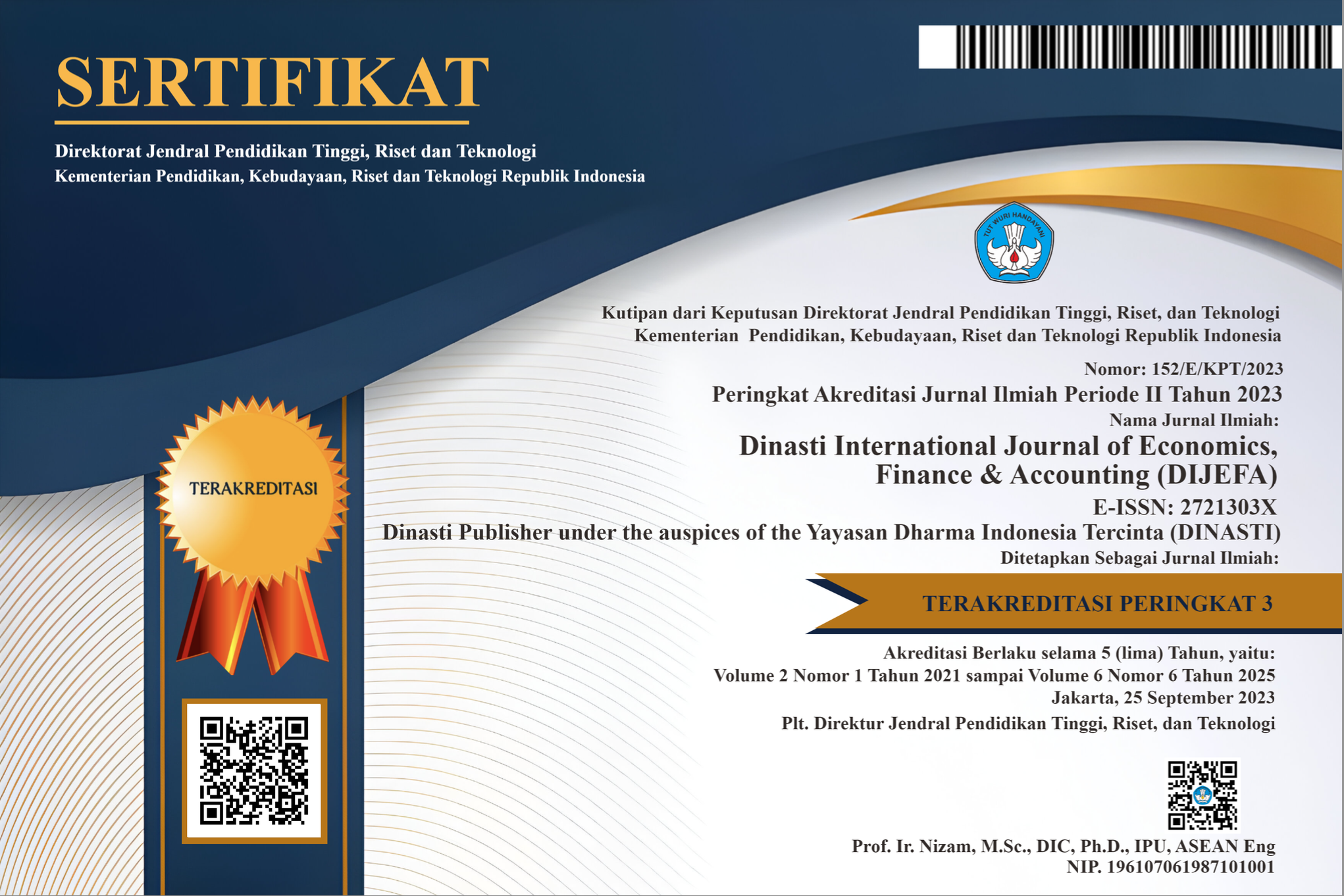Analysis of XYZ KAP Auditors Understanding of The Implementation of Private Entity SAK (SAK EP)
DOI:
https://doi.org/10.38035/dijefa.v6i1.3998Keywords:
Auditor Understanding, Private Entity SAK, Public Accounting Firm, Financial Statements, Quantitative MethodsAbstract
Abstract Private Entity Financial Accounting Standards (SAK) are prepared to meet the financial reporting needs of private entities. The implementation of Private Entity Financial Accounting Standards (SAK EP) which will be enforced in 2025 requires auditors to have a deep understanding of the standards. This study aims to analyze the level of understanding of auditors at XYZ Public Accounting Firm (KAP) towards SAK EP. The research method used is a quantitative approach using a questionnaire as a data collection instrument. The questionnaire was distributed to auditors to measure their level of knowledge about the basic concepts, principles, and application of SAK EP in the financial statement audit process. This study is expected to provide an overview of auditor readiness in facing the implementation of SAK EP and become a basis for designing more effective training programs in the future.
References
Arikunto, S. (2017). Metodologi Penelitian Kualitatif dan KuantiTatif. Jakarta: Gramedia.
Hidayati, M., Anggraeni, A. F., Evi, T., Rahmadi, Z. T., Asri, M., Kusmila, Z., Putri, N. J., Zuhroh, S., Haryanti, C. S., & Sukmawati, E. (2023). TEORI AKUNTANSI: Pengantar dan Penerapan Konsep-konsep Akuntansi. PT. Sonpedia Publishing Indonesia.
Ikatan Akuntansi Indonesia. (2021). Standar akuntansi keuangan. Salemba Empat.
Iluwati, J., Sherly, S., & Febriana, H. (2022). Comparison Analysis of Accounting Standards for Entities Without Public Accountability and Financial Standards for Private Entities of SMEs in Indonesia. International Journal of Social Science, Education, Communication and Economics (SINOMICS JOURNAL), 1(5), 631–640.
Kamil, I., Yolifiandri, Y., Irawan, I. A., Watriningsih, W., & Ariyani, M. (2024). Analysis of Accounting Perceptions and Knowledge in The Implementation of Private Entity Account (EP) in The Preparation of Financial Reports. International Journal of Business, Humanities, Education and Social Sciences (IJBHES), 6(2), 153–160.
Khairiyah, N. M., Sari, D. H., & Ramli, R. (2024). Analisis Penerapan SAK Entitas Privat (SAK EP) Pada Laporan Keuangan Koperasi CNS. SEIKO: Journal of Management & Business, 7(1).
Maulana, J., & Marismiati, M. (2023). Analisis Penerapan SAK Entitas Privat (SAK EP) pada Laporan Keuangan Koperasi XYZ. Land Journal, 4(2), 101–107.
Nuraini, S. (2022). Pengaruh Kesiapan Kompetensi Akuntansi Guna Meningkatkan Kualitas Laporan Keuangan Berdasarkan Standar Akuntansi Keuangan Entitas PrivaT (SAK EP) di Masa Mendatang (Studi Kasus Pada Koperasi Pegawai Pemerintah Kota Bandung). Universitas Koperasi Indonesia.
Pratama, A., Ismail, R. F., Muhammad, K., & Yadiati, W. (2024). Accounting Standard for Private Entities: are They Truly Useful?(Survey among Accounting Stakeholders in West Java, Indonesia). Journal of Ecohumanism, 3(8), 1–17.
Suhendar, E., Rusmana, O., & Putri, N. K. (2023). Analisis Persepsi Dan Pengetahuan Akuntansi Pengguna SAK Etap Terhadap Sak Entitas Privat (EP) Pada Penyusunan Laporan Keuangan (Studi Empiris Pada Koperasi Di Kota Banjar, Jawa Barat). Jurnal Ilmiah Mahasiswa Ekonomi Akuntansi, 8(3).
Sulistyawati, L. I. (2024). Perlakuan Akuntansi Aset Tetap dan Pengaruhnya Terhadap Laporan Keuangan PT NNI Berdasarkan Standar Akuntansi Keuangan Entitas Privat. Politeknik Negeri Bali.
Susanti, E., Azmansyah, A., & Nurjannah, H. (2023). Pelatihan Pelaporan Keuangan Koperasi Berdasarkan Standar Akuntansi Keuangan Entitas Privat (SAK EP) di Kabupaten Meranti. Community Engagement and Emergence Journal (CEEJ), 4(3), 350–355.
Downloads
Published
How to Cite
Issue
Section
License
Copyright (c) 2025 Zakkiandri Zakkiandri

This work is licensed under a Creative Commons Attribution 4.0 International License.
Authors who publish their manuscripts in this journal agree to the following conditions:
- The copyright on each article belongs to the author(s).
- The author acknowledges that the Dinasti International Journal of Economics, Finance & Accounting (DIJEFA) has the right to be the first to publish with a Creative Commons Attribution 4.0 International license (Attribution 4.0 International (CC BY 4.0).
- Authors can submit articles separately, arrange for the non-exclusive distribution of manuscripts that have been published in this journal into other versions (e.g., sent to the author's institutional repository, publication into books, etc.), by acknowledging that the manuscript has been published for the first time in the Dinasti International Journal of Economics, Finance & Accounting (DIJEFA).


























































